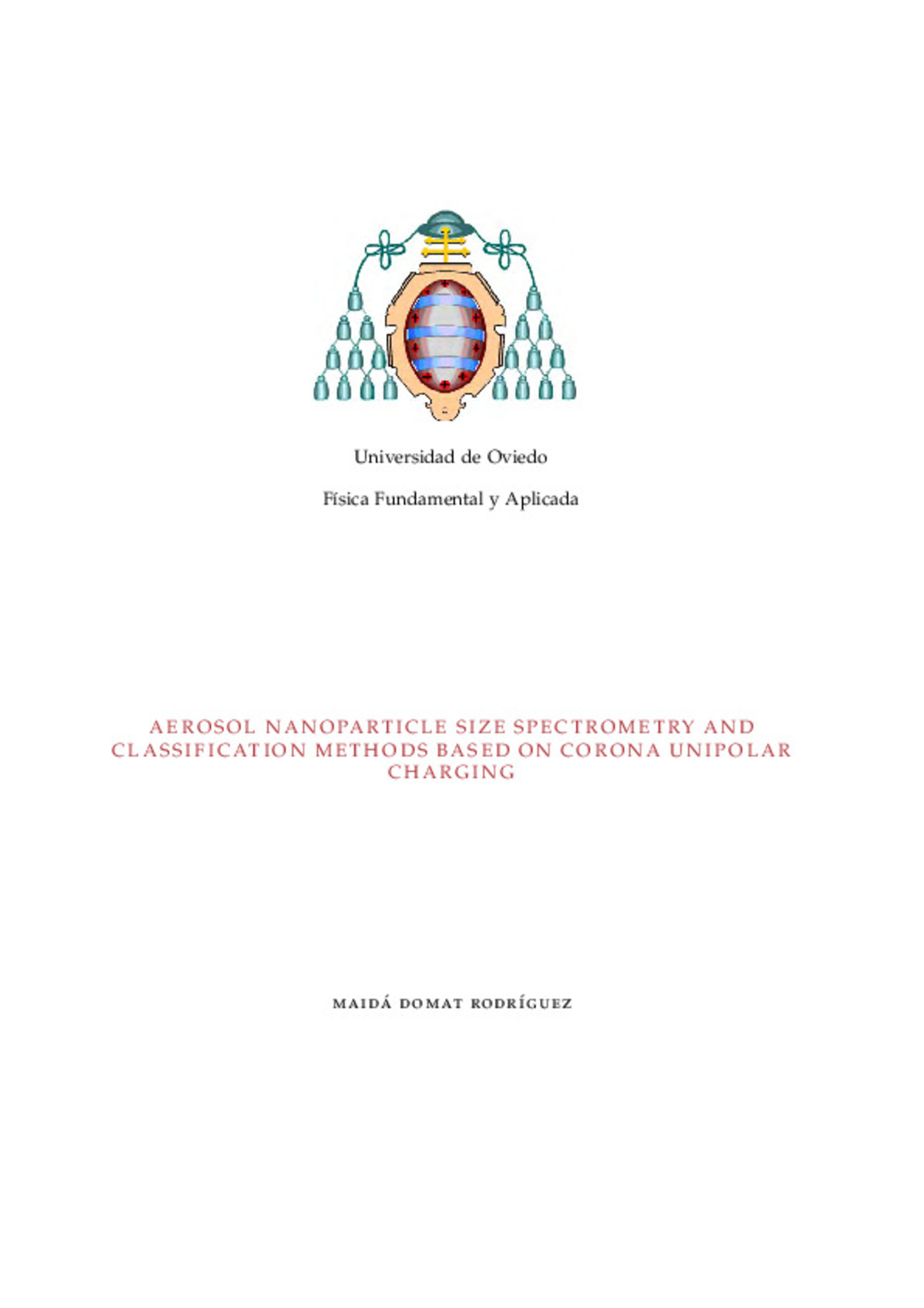Aerosol nanoparticle size spectrometry and classification methods based on corona unipolar charging.
Autor(es) y otros:
Director(es):
Centro/Departamento/Otros:
Palabra(s) clave:
Física fundamental y aplicada
Física de la fase gaseosa
Ionización
Física molecular
Fecha de publicación:
Descripción física:
Resumen:
The accurate determination of the particle size distribution function is a fundamental problem in aerosol science. It is usually determined by electrical mobility-based measurements, where the electrical charge to particles is usually applied by radioactive bipolar chargers, although new electrical charging techniques are arising. An efficient and versatile unipolar corona charger was developed. It has indirect charging characteristics, with corona and charging regions separated. Ions were generated by a needle electrode and then driven to the charging region by a sheath flow in order to reduce the electrostatic loss of nanoparticles. The distance of the electrode to the walls can be adjusted by a micrometer, modifying the onset voltage and Nit-product, and therefore the intrinsic and extrinsic charging efficiencies and loss of charged particles. Experimental results indicate that the generated ion current is practically the same independently of the variation in applied voltage or corona current, but varying the electrode gap distance seems to be a much more efficient way to regulate the Nit-product. The charging efficiency can vary from high values, comparable to the higher efficiency chargers presented in literature, to lower levels such as reached with bipolar chargers. A model for unipolar charging of nanoparticles based on the Fuchs birth-and-death theory is developed. It includes both diffusional and electrical losses for particles and ions. Electrical losses are modeled by inclusion of a radial electric field which is caused by space charge. The model can be used to obtain the initial ion concentration and mean radial electric field from data of charge distribution fractions, without additional measurements. It was successfully applied to results from three different unipolar chargers. In all cases, good agreement between experimental and modeling results has been obtained. The model can be used to assist the operation of unipolar chargers, e.g. by predicting charging efficiencies for particle sizes which are not experimentally accessible. Once the characteristics of the particle charging are defined, the inversion of the particle size distribution from electrical mobility measurements is analyzed. Three different methods are adapted for a dot-matrix approach to the problem, especially for non-square or singular matrices, and applied to the electrical mobility measurements from fixed or scanning voltages. Multiple charged particles, diffusion losses, arbitrary voltage steps and noise have been considered, which results in non-adjoining and overlapping transfer functions. The individual contributions of the transfer functions in each size interval were geometrically estimated, requiring only its characteristic mobilities. The choice of the number of data and size channels is shown to be especially important, since it alters the rank of the kernel matrix and the accuracy of the inverted results. The methodology is applied to unipolar and bipolar chargers, being extrapolable to any charging method with a defined charge distribution, and retrieval of the singly charged particle distribution and mean charge from a Tandem-DMA configuration was successfully demonstrated.
The accurate determination of the particle size distribution function is a fundamental problem in aerosol science. It is usually determined by electrical mobility-based measurements, where the electrical charge to particles is usually applied by radioactive bipolar chargers, although new electrical charging techniques are arising. An efficient and versatile unipolar corona charger was developed. It has indirect charging characteristics, with corona and charging regions separated. Ions were generated by a needle electrode and then driven to the charging region by a sheath flow in order to reduce the electrostatic loss of nanoparticles. The distance of the electrode to the walls can be adjusted by a micrometer, modifying the onset voltage and Nit-product, and therefore the intrinsic and extrinsic charging efficiencies and loss of charged particles. Experimental results indicate that the generated ion current is practically the same independently of the variation in applied voltage or corona current, but varying the electrode gap distance seems to be a much more efficient way to regulate the Nit-product. The charging efficiency can vary from high values, comparable to the higher efficiency chargers presented in literature, to lower levels such as reached with bipolar chargers. A model for unipolar charging of nanoparticles based on the Fuchs birth-and-death theory is developed. It includes both diffusional and electrical losses for particles and ions. Electrical losses are modeled by inclusion of a radial electric field which is caused by space charge. The model can be used to obtain the initial ion concentration and mean radial electric field from data of charge distribution fractions, without additional measurements. It was successfully applied to results from three different unipolar chargers. In all cases, good agreement between experimental and modeling results has been obtained. The model can be used to assist the operation of unipolar chargers, e.g. by predicting charging efficiencies for particle sizes which are not experimentally accessible. Once the characteristics of the particle charging are defined, the inversion of the particle size distribution from electrical mobility measurements is analyzed. Three different methods are adapted for a dot-matrix approach to the problem, especially for non-square or singular matrices, and applied to the electrical mobility measurements from fixed or scanning voltages. Multiple charged particles, diffusion losses, arbitrary voltage steps and noise have been considered, which results in non-adjoining and overlapping transfer functions. The individual contributions of the transfer functions in each size interval were geometrically estimated, requiring only its characteristic mobilities. The choice of the number of data and size channels is shown to be especially important, since it alters the rank of the kernel matrix and the accuracy of the inverted results. The methodology is applied to unipolar and bipolar chargers, being extrapolable to any charging method with a defined charge distribution, and retrieval of the singly charged particle distribution and mean charge from a Tandem-DMA configuration was successfully demonstrated.
Notas Locales:
DT(SE) 2014-083
Colecciones
- Tesis [7670]
- Tesis doctorales a texto completo [2163]
Ficheros en el ítem





